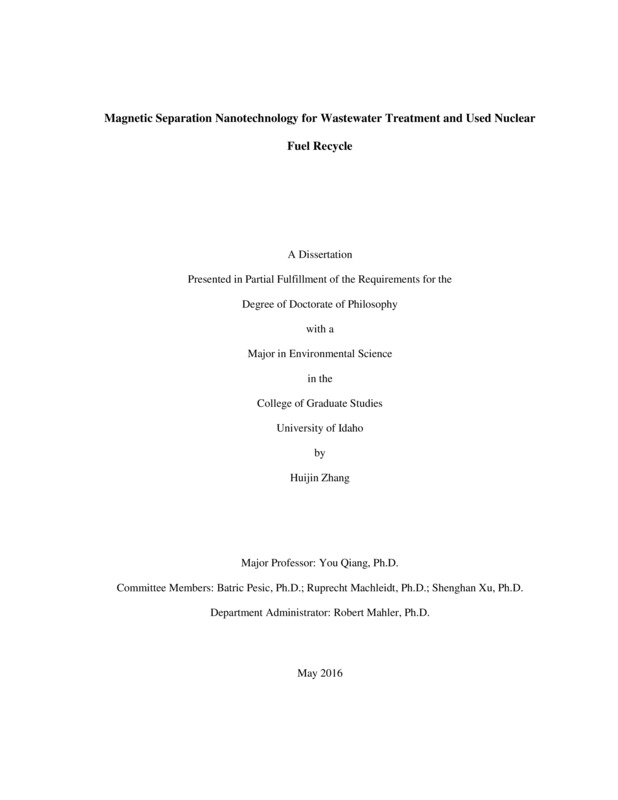Magnetic Separation Nanotechnology for Wastewater Treatment and Used Nuclear Fuel Recycle
Zhang, Huijin. (2016). Magnetic Separation Nanotechnology for Wastewater Treatment and Used Nuclear Fuel Recycle. Theses and Dissertations Collection, University of Idaho Library Digital Collections. https://www.lib.uidaho.edu/digital/etd/items/zhang_idaho_0089e_10785.html
- Title:
- Magnetic Separation Nanotechnology for Wastewater Treatment and Used Nuclear Fuel Recycle
- Author:
- Zhang, Huijin
- Date:
- 2016
- Embargo Remove Date:
- 2017-05-19
- Keywords:
- Heavy metal Magnetic nanoparticle Magnetic separation Nuclear waste Sorption
- Program:
- Environmental Science
- Subject Category:
- Environmental science
- Abstract:
-
Magnetic separation nanotechnology is an upcoming technology in the field of wastewater and nuclear waste treatment and environmental remediation for heavy metal and radioactive contaminants. Traditional separation methods such as centrifugation and filtration are usually labor-consumptive, uneconomical and thus impractical for large-scale water treatment. From this point of view, magnetic nanosorbents exhibit special superiority due to convenient separation by an external magnetic field. Other advantages of magnetic nanosorbents are low inventory utilization of nanosorbents, enhanced metal sorption efficiency and selectivity, and low production of secondary waste. This dissertation presents the study on our lab-made magnetic nanosorbents (referred to as dMNP-DTPA) – double coated magnetic nanoparticles (dMNP) coupled with diethylene triamine pentaacetic acid (DTPA) and their potential to be used as effective sorbent materials to remove metal ions (bivalent heavy metals and trivalent lanthanides) from aqueous solutions. The metal sorption results show that the magnetic nanosorbents developed in our study possess a high stability, fast kinetics, and high sorption efficiency in harsh environments. The metal sorption on the dMNP-DTPA nanosorbents is reversible so that the metal-loaded dMNP-DTPA can be fast and effectively regenerated by the dilute acids. The sorption/desorption cycle experiments demonstrate that the dMNP-DTPA nanosorbents can be reused for a long time which helps to offset the synthesis cost and makes this technique cost-effective. To better explore the dynamic behavior of MNPs in a continuous flow, a simulation tool, Computational Fluid Dynamics (CFD), is applied in this study. The CFD models will help us to design a separation system that can be operated under continuous flow conditions.
- Description:
- doctoral, Ph.D., Environmental Science -- University of Idaho - College of Graduate Studies, 2016
- Major Professor:
- Qiang, You
- Committee:
- Pesic, Batric; Machleidt, Ruprecht; Xu, Shenghan
- Defense Date:
- 2016
- Identifier:
- Zhang_idaho_0089E_10785
- Type:
- Text
- Format Original:
- Format:
- application/pdf
- Rights:
- In Copyright - Educational Use Permitted. For more information, please contact University of Idaho Library Special Collections and Archives Department at libspec@uidaho.edu.
- Standardized Rights:
- http://rightsstatements.org/vocab/InC-EDU/1.0/

